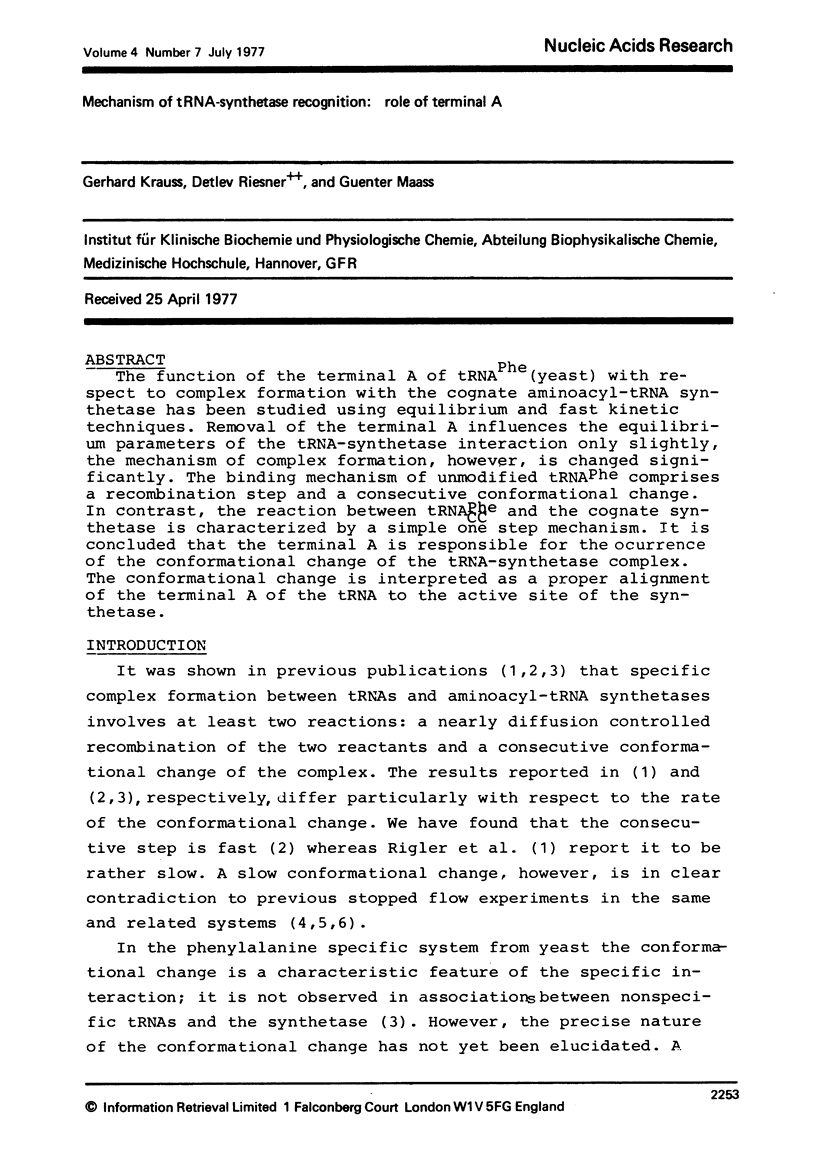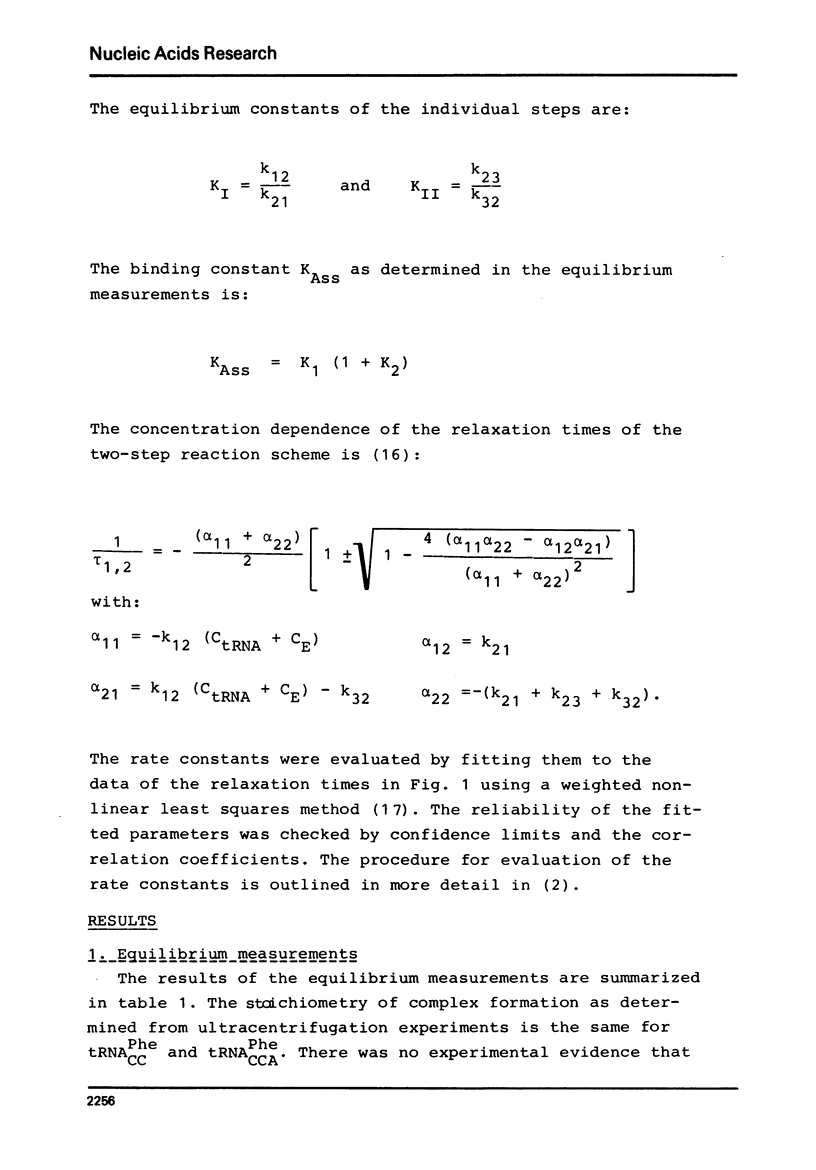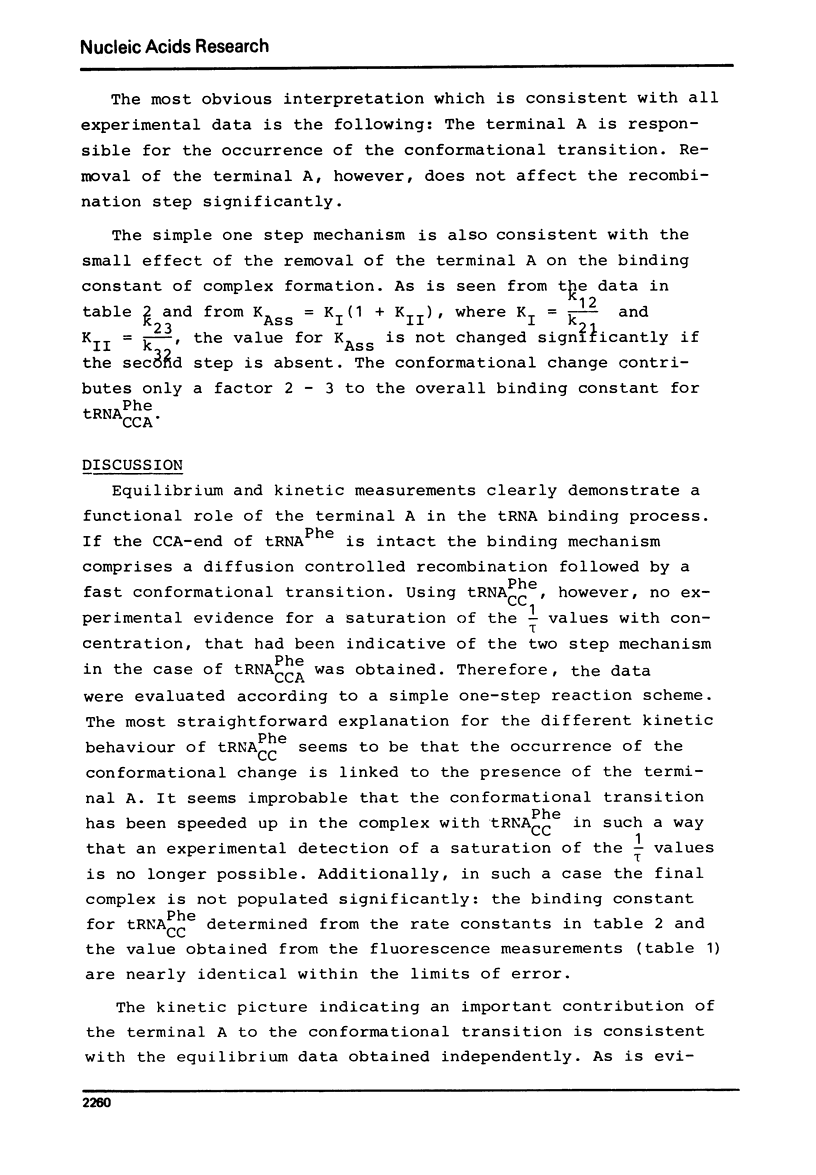Abstract
The function of the terminal A of tRNA Phe (yeast) with respect to complex formation with the cognate aminoacyl-tRNA synthetase has been studied using equilibrium and fast kinetic techniques. Removal of the terminal A influences the equilibrium parameters of the tRNA-synthetase interaction only slightly, the mechanism of complex formation, however, is changed significantly. The binding mechanism of unmodified tRNAPhe comprises a recombination step and a consecutive conformational change. In contrast, the reaction between tRNAPheCC and the cognate synthetase is characterized by a simple one step mechanism. It is concluded that the terminal A is responsible for the occurrence of the conformational change of the tRNA-synthetase complex. The conformational change is interpreted as a proper alignment of the terminal A of the tRNA to the active site of the synthetase.
Full text
PDF









Selected References
These references are in PubMed. This may not be the complete list of references from this article.
- Blanquet S., Dessen P. Antico-operative binding of bacterial and mammalian initiator tRNAMet to methionyl-tRNA synthetase from escherichia coli. J Mol Biol. 1976 Jun 5;103(4):765–784. doi: 10.1016/0022-2836(76)90208-4. [DOI] [PubMed] [Google Scholar]
- Eigen M. New looks and outlooks on physical enzymology. Q Rev Biophys. 1968 May;1(1):3–33. doi: 10.1017/s0033583500000445. [DOI] [PubMed] [Google Scholar]
- Fersht A. R., Kaethner M. M. Enzyme hyperspecificity. Rejection of threonine by the valyl-tRNA synthetase by misacylation and hydrolytic editing. Biochemistry. 1976 Jul 27;15(15):3342–3346. doi: 10.1021/bi00660a026. [DOI] [PubMed] [Google Scholar]
- Krauss G., Peters F., Maass G. Effect of excision of the Y-base on the interaction of tRNAPhe (yeast) with phenylalanyl-tRNA synthetase (yeast). Nucleic Acids Res. 1976 Mar;3(3):631–639. doi: 10.1093/nar/3.3.631. [DOI] [PMC free article] [PubMed] [Google Scholar]
- Krauss G., Pingoud A., Boehme D., Riesner D., Peters F., Maas G. Equivalent and non-equivalent binding sites for tRNA on aminoacyl-tRNA synthetases. Eur J Biochem. 1975 Jul 15;55(3):517–529. doi: 10.1111/j.1432-1033.1975.tb02189.x. [DOI] [PubMed] [Google Scholar]
- Krauss G., Riesner D., Maass G. Mechanism of discrimination between cognate and non-cognate tRNAs by phenylalanyl-tRNA synthetase from yeast. Eur J Biochem. 1976 Sep;68(1):81–93. doi: 10.1111/j.1432-1033.1976.tb10766.x. [DOI] [PubMed] [Google Scholar]
- Krauss G., Römer R., Riesner D., Maass G. Thermodynamics and kinetics of the interaction of phenylalanine-specific tRNA from yeast with its cognate synthetase as studied by the flourescence of the Y-base. FEBS Lett. 1973 Feb 15;30(1):6–10. doi: 10.1016/0014-5793(73)80606-4. [DOI] [PubMed] [Google Scholar]
- Litt M. A simple procedure for the purification of yeast phenylalanine transfer RNA. Biochem Biophys Res Commun. 1968 Aug 13;32(3):507–511. doi: 10.1016/0006-291x(68)90691-8. [DOI] [PubMed] [Google Scholar]
- Pingoud A., Riesner D., Boehme D., Maass G. Kinetic studies on the interaction of seryl-tRNA synthetase with tRNA(Ser) and ser-tRNA(ser) from yeast. FEBS Lett. 1973 Feb 15;30(1):1–5. doi: 10.1016/0014-5793(73)80605-2. [DOI] [PubMed] [Google Scholar]
- Riesner D., Pingoud A., Boehme D., Peters F., Maass G. Distinct steps in the specific binding of tRNA to aminoacyl-tRNA synthetase. Temperature-jump studies on the serine-specific system from yeast and the tyrosine-specific system from Escherichia coli. Eur J Biochem. 1976 Sep;68(1):71–80. doi: 10.1111/j.1432-1033.1976.tb10765.x. [DOI] [PubMed] [Google Scholar]
- Rigler R., Pachmann U., Hirsch R., Zachau H. G. On the interaction of seryl-tRNA synthetase with tRNA Ser. A contribution to the problem of synthetase-tRNA recognition. Eur J Biochem. 1976 May 17;65(1):307–315. doi: 10.1111/j.1432-1033.1976.tb10418.x. [DOI] [PubMed] [Google Scholar]
- Sprinzl M., Cramer F. Site of aminoacylation of tRNAs from Escherichia coli with respect to the 2'- or 3'-hydroxyl group of the terminal adenosine. Proc Natl Acad Sci U S A. 1975 Aug;72(8):3049–3053. doi: 10.1073/pnas.72.8.3049. [DOI] [PMC free article] [PubMed] [Google Scholar]
- Sternbach H., von der Haar F., Schlimme E., Gaertner E., Cramer F. Isolation and properties of tRNA nucleotidyl transferase from yeast. Eur J Biochem. 1971 Sep 24;22(2):166–172. doi: 10.1111/j.1432-1033.1971.tb01528.x. [DOI] [PubMed] [Google Scholar]
- Tal J., Deutscher M. P., Littauer U. Z. Biological activity of Escherichia coli tRNA Phe modified in its C-C-A terminus. Eur J Biochem. 1972 Aug 4;28(4):478–491. doi: 10.1111/j.1432-1033.1972.tb01935.x. [DOI] [PubMed] [Google Scholar]
- Von Der Haar F., Gaertner E. Phenylalanyl-tRNA synthetase from baker's yeast: role of 3'-terminal adenosine of tRNA-Phe in enzyme-substrate interaction studied with 3'-modified tRNA-Phe species. Proc Natl Acad Sci U S A. 1975 Apr;72(4):1378–1382. doi: 10.1073/pnas.72.4.1378. [DOI] [PMC free article] [PubMed] [Google Scholar]
- von der Haar F., Cramer F. Hydrolytic action of aminoacyl-tRNA synthetases from baker's yeast: "chemical proofreading" preventing acylation of tRNA(I1e) with misactivated valine. Biochemistry. 1976 Sep 7;15(18):4131–4138. doi: 10.1021/bi00663a034. [DOI] [PubMed] [Google Scholar]


